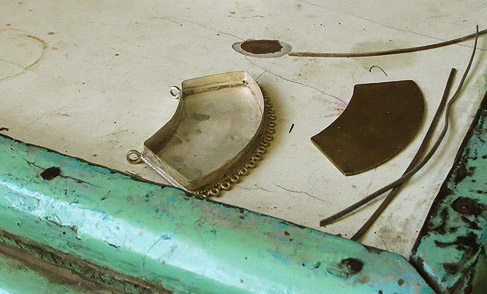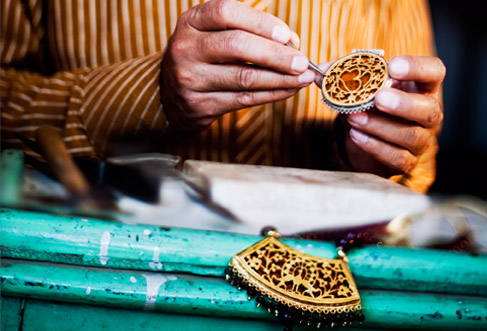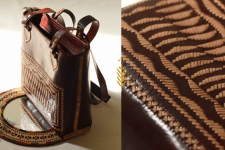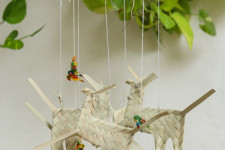- Availability: Out Of Stock
- Made & Mkt by: Bhagyanti
- Product Code: BJ-638
- Weight: 60.00g
The typical dispatch time is 2-3 days; however, in special cases, it may take longer. Please refer to the product details section for specific timelines. Once dispatched, we will share the tracking details with you.
For returns, you can file a request within 24 hours of receiving the product. If the package is damaged, please make a video while unboxing and share images of the damaged item along with your return request.
There are some who need a tree to meditate. And some who need music. But then there are those, who fend for gold. Because the fine nuances of creating intricate patterns in gold require such keen patience and concentration, that the art indeed becomes a true meditative bliss to the senses. And the gratification of coming the closest, that any mortal’s tactile memory can ever get, to touch a piece of art as overwhelming and magnificent, as the idea of god himself.
When the hunting tigers and Stags from the wild imagination of Nathuji sonidescended onto the canvas of gold, Theva was born about 500 years ago. It is believed that this magnificent art wrapped around a big box impressed Raja Savant Singh of Pratapgarh so much that he bestowed immense wealth upon the soni (goldssmith) and rewarded him with the title of ‘Rajsoni’- The chief jeweler of the court. Both the title and the craft are being passed on through generations. Mutual learning amongst family and friends has made it into a small cluster of craftsmen who perform this craft rather secretively.
Theva comes from two words of the local dialect, ‘Tharna’ – meaning to hammer(to get thin foils of gold from very small quantity of the metal) and ‘Vada’ – meaning silver wire (which in the loop form makes the resting foundation for the main piece), both being the most important aspects of the art. While the forefathers of this art only made chests and boxes, today the masters of this skill have extend their expertise tophoto frames, mirrors, cufflinks, brooches, trays, plates and personal accessories like rings and necklaces which are adorned by men and women alike. The inspiration for this art comes from the Mogul miniature paintings involving traditional design subjects ranging from mythological genres to the more secular themes. Today the art has acquired a more unique stance than ever because the conventional style has been blended with a variety of techniques like Meenakari, diamond setting etc and a new palette of materials, which includes – beads, threads and others lending a contemporary idiom to the time honored practice.
Thirty two year old Rakesh soni is a descendent of Nathuji soni and continues to dwell in the competence of this art. Besides being conferred with State and National Awards, Rakeshji and his wife Usha Soni have been recognized byUNESCO as well. The Government of India has even issued a stamp featuring an awe-inspiring piece of theva on a plate in 2002. But no material honor can compete with what the Rajsoni has accomplished for himself by ritualistically engaging himself in this art of controlled precision – a calm and collected temperament that leaves him happy to confess - ”I’ve lost the ability to ever get angry”. The craft requires a working plane made locally using ‘chapadi’ (purified lac) to create a hard bed. Pure 23-carat gold, silver strips, Belgian glass and strings of beads and stones are amongst the other raw materials involved.
Small pieces of gold are beaten into several slender sections, about one tenth of a millimeter thin and mounted like a canvas mat on the lac plate. When the plate is warmed, the metal gets slightly embedded into the lac. Tools such as ‘Hummaney’ (forsep), ‘Katya’ (cutter) and ‘Tankale’ (to cut out the jaali) are then required to sketch and precisely cut out the pattern on the gold foil. The patterns either carry local narratives of hunting expeditions within miniature foliage and streams, animals and birds or they indicate the nature of indigenous myth like pictures of Radha Krishna, Sri Ram or Hanumanji.
It becomes essential to constantly check on the lac bed for air bubbles else it may cause an avoidable denting of the fragile gold foil. Master craftsmen however do not sketch; instead they directly puncture the blueprint with fine chisels and sharp tools. But such is the single minded attention required, that any error or deviation in the process of splitting the pattern can result in the entire piece of foil being wasted. All such discarded pattern sheets and cut outs from the jail are melted again and prepared for the fresh work.
The entire jali is then laid out in a frame of silver wire called “vaada” to lessen the risk of damage. The silver wire frame used in this task is pre-assembled on brass dies and soldered to precision. The entire framed composition is then set out on a mica sheet using forceps with extremely controlled and steady hands. Once pinned together over the mica, the two metals can be easily soldered and the mica is then removed. The delicate entity so obtained is then placed on a piece of colored Belgian glass using a bonding technique that remains to be a unique secret within the family. A solid silver casing called ‘chandi ki dibiya’ is then used to enclose the entire composition including the Belgian glass.
To add further glint to the piece, an extra layer of shiny foil is placed on the bed of the ‘dibiya’. The beauty of this art lies in the fact that, even though the amount of gold used is minimal, the eventual product gives an impression of a gold-rich heavily ornamented piece. A 4” X 6” photo frame requires only 5-6 grams of gold, but it gives the illusion of a gold feast to the eyes. The entire procedure is meticulously carried out in daylight only.
The art has remained a guarded secret…. even the daughters of the family are kept ignorant about the master stroke technique, considering that they will eventually settle out of the clan. The boys of the house on the other hand are trained in sketching patterns from the age of ten, so that when they finally start to practice the art, the language and expression of these jaali scenes unconsciously and effortlessly flows out of their hands, directly into the foil.
The ever-increasing prices of gold have rendered this practice as a good deal for those who subscribe to more value for less money. ~
| Craftsmen | |
| Made by | Bhagyanti jewelers |
| City | Rampura, Neemuch |
| Returns and Exchange | |
| Note | Gold: 2.5 gm Silver: 15 gm Belgium glass Semi precious stone |
| Shipping ~ | |
| Location | Only shipped India (Not shipped internationally) |
| Material | |
| Made of | Gold, Silver, Belgium glass, Beads |
| Instruction | |
| Note | The items in this category are handmade and unique. These may differ slightly from the images shown. |
| Restrictions | |
| COD - Option | COD unavailable |
| International Shipping | NO |



























-225x150w.jpg)
-225x150w.jpg)
-225x150w.jpg)
-225x150w.jpg)
-225x150w.jpg)
-225x150w.jpg)
-225x150w.jpg)
-225x150w.jpg)
-225x150w.jpg)
-225x150w.jpg)
-225x150w.jpg)
-225x150w.jpg)

-225x150w.jpg)

-225x150w.jpg)



-225x150w.jpg)

-225x150w.jpg)













-225x150w.jpg)

-225x150w.jpg)

-225x150w.jpg)

